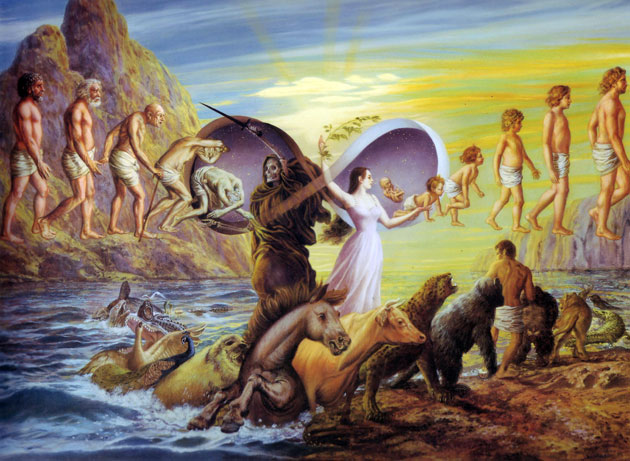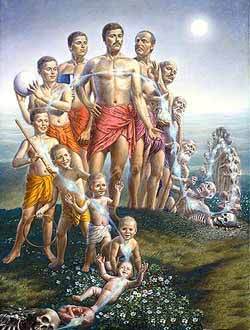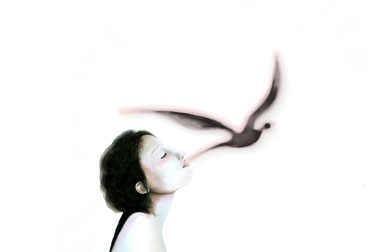Evidence for Reincarnation
By Madhavendra Puri Dasa

Dr. Stevenson has devoted the last forty years to the scientific documentation of pas life memories of children from all over the world. He has over 3000 cases in his files. Many people, including skeptics and scholars, agree that these cases offer the best evidence yet for reincarnation.
Forty years of research by Professor Ian Stevenson (University of Virginia) provides impressive evidence that each one of us is different from his/her physical body and is able to function independently of it. Stevenson has published dozens of carefully-researched cases (see bibliography) in which young children report verifiable details of what they claim were previous lives. The following is a typical case in terms of obscure and detailed information reported by the child. It is atypical in that the previous personality predicted his rebirth.
Obscure and Verifiable Details
In 1945 Victor Vincent, a resident of Sitka, Alaska, informed a young friend of his, Mrs. Chotkin, that he was to die soon and be reborn as her son. He expressed the desire that in his next life as her son he would not stutter as he did in this life. He pulled up his shirt and showed her a scar on his back that was the result of a surgical operation performed several years earlier. The small round holes of the stitches were clearly visible. He also showed her a scar on the right side of his nose (near the eye) that was the result of a surgical operation there.
He informed her that in his next life as her son he would have the same marks on his body in the same places, and thereby she would be able to recognize him as Victor Vincent reborn.
A year later he died. Eighteen months thereafter Mrs. Chotkin gave birth to a boy she named Corliss. She told Stevenson that on the body of Corliss at the time of his birth were the same marks, in the same places, as those on the body of Victor Vincent. In 1962 Stevenson visited Alaska and described the mark on Corliss’s back: “It was heavily pigmented and raised. It extended about one inch in length and a quarter inch in width. Along its margins one could still easily discern several small round marks outside the main scar. Four of these on one side lined up like the stitch wounds of surgical operations” (Stevenson, 1974, p.260).
Eliminating Alternate Explanations
Critics claiming fraud by Mrs. Chotkin for monetary gain are silenced by Stevenson’s report that she gained no money from him or anyone else. The claim that she faked the case for notoriety is refuted by the fact that hardly anyone (including her own daughter) was aware that she believed Corliss was Victor Vincent reborn. The claim that she faked the birthmarks is hard to believe, since she was a simple housewife with no access to the sophisticated lab equipment required to fake birthmarks. In fact, it is doubtful that anyone in the world in 1962 would have been able to fake the birthmarks well enough to fool Stevenson (himself an M.D. and professor).
One day when Corliss’s mother was trying to get him to say his name, instead of saying the name “Corliss” he said “Don’t you know me? I’m Kahkody” (Stevenson, 1974, p.260). Kahkody was a nickname of Victor Vincent.
Corliss identified strongly with Victor Vincent and was able to spontaneously recognize a number of people that Victor Vincent had known. Stevenson (1974, p.261) said that when Corliss was two years old he recognized Victor Vincent’s son named William. Corliss saw him on the street and spontaneously said, “There is William, my son.”
About that same time Corliss also spontaneously recognized a stepdaughter of Victor Vincent’s. He saw her at the docks of Sitka and correctly said her name, Susie. At that time he was being pushed by his mother along the street in a carriage.
Stevenson said that Corliss exhibited great excitement when he saw her, so much so that he was jumping up and down. He said, “There is my Susie.” Corliss also hugged her with great affection. Corliss recognized Susie before his mother had noticed her. Stevenson mentioned that Mrs. Chotkin did not go to the docks with the intention of meeting Susie. In a similar way, when Corliss was three years old he spontaneously recognized and Victor Vincent’s widow and called her by her correct name, Rose. He recognized her in a crowd of people before Mrs. Chotkin had seen her. Stevenson reported that Corliss also recognized a number of other people that Victor Vincent had known.
Stevenson (1974, p.261-262) wrote that Corliss was able to provide a detailed account of certain events that had occurred in the life of Victor Vincent. One day Corliss related an experience Vincent had had when he was out on a fishing trip. The engine of Vincent’s boat had broken and left him helpless in one of the many hazardous channels of southeastern Alaska. Vincent wanted to attract the attention of any ship that might be passing by, but he thought that most crews would not take much notice of an ordinary fisherman. It turns out that he happened to be a part-time worker for the Salvation Army, and he had with him a Salvation Army uniform. He put on this uniform and rowed in a small boat to attract the attention of a passing ship named the North Star. He asked some of the crew members to deliver a message for him. Mrs. Chotkin heard this story directly from Victor Vincent himself when he was alive. She was sure that Corliss had not heard the story from her or her husband before he told it to them.

On another occasion Mrs. Chotkin and Corliss were at the house that was previously owned by Mrs. Chotkin and her family during the life of Victor Vincent. Corliss pointed to a room in the house and said that he (as Vincent) and his wife had slept in this room when they visited the Chotkins. This statement is impressive since at the time Corliss was visiting the house, it had been reorganized and was being used for purposes other than an ordinary residential house. None of the rooms in it were recognizable as bedrooms. But the room that Corliss pointed to had in fact been occupied by Victor Vincent and his wife when they had visited the Chotkins.
The claim that Corliss acquired all this information by psychic power (and hence reincarnation is not required to explain the informational aspects of this and other similar cases) is refuted by the observation that Corliss was unable to provide such impressive information about anyone other than Victor Vincent. The same is true for the many other cases reported by Stevenson.
Mrs. Chotkin told Stevenson that certain of Corliss’s behavior patterns closely resembled those of Victor Vincent. She mentioned that Corliss combed his hair forward over his forehead in the same way that Vincent had done, although she had tried to train Corliss to comb his hair in exactly the opposite manner.
As mentioned earlier, Victor Vincent stuttered severely and told Mrs. Chotkin a year before his death that he hoped he would stutter less in his next life as her son. Corliss also stuttered severely when he was young, until he received speech therapy around the age of ten. Vincent was a very religious Christian.
When Corliss was young, he expressed similar devoutness. Vincent was very fond of handling boats and living on the water. Corliss had the same interest. In fact, Corliss surprised his parents by repairing a boat engine without any training. Both Vincent and Corliss were left-handed.
Correlation Between Birthmarks and Wounds
Stevenson (1987, p.101) wrote that he had researched hundreds of cases in which a child claiming reincarnation had distinctive birthmarks supporting this claim, and in about thirty cases he had obtained independent corroboration (in the form of medical records or autopsies) of similar marks on the body of the previous personality. These are described in Stevenson (1997).
There are many cases in which a child reported that he was violently murdered (usually by shooting or stabbing) in his previous life, and the child had on his body a birthmark of the same shape and in the same place as the fatal wound in his previous life. Stevenson wrote (1987, p.101): “Birthmarks and birth defects related to the previous personality seem to me to provide some of the strongest evidence in favor of reincarnation as the best interpretation for the cases. They are objectively observable (I have photographed several hundred of them), and for most of them the only serious alternative explanation that I can think of is a psychic force on the part of the baby’s mother that influences the body of the embryo or fetus within her. However, this explanation, which is itself almost as mind-stretching (for the average Westerner) as reincarnation, can be firmly excluded in about twelve cases in which the child’s mother and father had never heard of the identified previous personality until after the child’s birth.”
Those who want to eliminate the hypothesis of reincarnation and explain everything as psychic force on the part of the child must take into account the fact that the marks are present on the child’s body at the time of birth. This means that the child would have had to be able to wield this psychic force while in his mother’s womb, which is more consistent with the hypothesis of reincarnation than psychic force without reincarnation.
Functioning Without a Physical Body
Dr. Stevenson reported a number of cases in which the conscious self existed for days, weeks and even years without a physical body and acquired information by transcorporal senses. (Transcorporal senses refer to senses that are different from those of the physical body and able to function independently of it.) For example, a Thai boy named Bongkuch Promsin claimed that in his previous life he was a Laotian man named Chamrat who was stabbed to death (Stevenson, 1987, p.68). After the murder, the conscious self that had resided in the body of Chamrat remained in a discarnate state for seven years, staying near a bamboo tree in the vicinity of the murder. One rainy day the discarnate Chamrat saw Bongkuch’s father and accompanied him home on a bus. Bongkuch’s father later told Stevenson that he happened to visit Hua Tanon (the place where Chamrat was murdered) shortly before his wife became pregnant with Bongkuch. Bongkuch’s father said that the day he went to Hua Tanon was in fact a rainy day.
An Indian boy named Veer Singh said that after the death of his previous body (belonging to a man named Som Dutt) he, as a discarnate conscious self, remained near Som Dutt’s family and observed their activities. Veer Singh said that he accompanied members of this family who left the house at night and went out alone. Stevenson said that Som Dutt’s mother had a dream in which Som Dutt told her that he had accompanied his brother a number of times when his brother had surreptitiously left the house at night to attend local fairs.
When this brother was asked, he admitted that he was in fact attending local fairs at night, but no one in the family knew about it until Som Dutt’s mother had this dream. Stevenson added that Veer Singh also knew about other private family affairs that took place after Som Dutt’s death and before Veer Singh was born, including the fact that the family bought a camel, that they were involved in a lawsuit, and that several children were born during this period (Stevenson, 1987, p.110).
The persons who reported seeing things in the discarnate state could not have been using physical eyes. Thus, the above evidence supports the hypothesis that the conscious self is inherently transcorporal and possesses transcorporal senses.
Reincarnation is a Natural Process That Happens to All of Us

The idea that reincarnation is a natural process that all conscious selves undergo when their physical bodies die is supported by Stevenson’s statements that it is easy to find persons who claim to remember a previous life in certain places such as West Africa, India, Sri Lanka, Burma, Thailand, Syria, Turkey, Lebanon and the northwestern part of North America (Stevenson 1980, p.13; 1987, p.93). Stevenson said that in these places he has received so many reports of possible cases that he simply did not have enough time to investigate them all. It is important to note that cases of the reincarnation type are found not only in southeast Asia but all over the world.
Stevenson wrote, “Fortunately, many new cases are available, and as I mentioned in the General Introduction to this series, I should have no difficulty whatever in indicating places in several countries where an investigator can easily find more cases of this type than he could possibly study” (Stevenson, 1980, p.351).
Stevenson mentioned that he has also found and investigated many cases of the reincarnation type in the other parts of North America and Europe. The lesser frequency of reported cases in these countries is due to the fact that many parents ignore or suppress their children’s statements that would support such cases, and hence they can not come to the attention of investigators like Stevenson (Stevenson, 1987, p.93-94). Careful studies by other scientists have uncovered dozens of cases similar to those reported by Stevenson. See, for example, Pasricha (1990, 1992, 1998), Mills (1989, 1990), Haraldsson (1991, 1997), and Keil (1996).
One might raise the following objection: “If reincarnation is actually true, why don’t I or more people I know remember a previous life?” A reasonable answer is that the power to remember a previous life is a rare talent like Einstein’s mathematical talent or Mozart’s musical talent. The fact that I and my friends do not have these talents does not mean that no one has these talents. Obviously Einstein and Mozart were real historical persons. Another important consideration is that there are things which we know we went through (such as being in our mother’s womb) but which we have no memory of. To say that I was not in my mother’s womb because I don’t remember it is clearly fallacious logic.
BIBLIOGRAPHY
Haraldsson, Journal of Scientific Exploration, 1997, 11(3), 323
Haraldsson, Journal of Scientific Exploration, 1991, 5(2), 233
Keil, Journal of Scientific Exploration, 1996, 10(4), 467
Mills, Journal of Scientific Exploration, 1990, 4(2), 171
Mills, Journal of Scientific Exploration, 1989, 3(2), 133
Pasricha, Journal of Scientific Exploration, 1998, 12(2), 259
Pasricha, Journal of Scientific Exploration, 1992, 6(2), 167
Pasricha, S., Claims of Reincarnation, New Delhi: Harman, 1990
Stevenson, I., Reincarnation and Biology, London: Praeger, 1997
Stevenson, I., Children Who Remember Previous Lives, University of
Virginia Press, 1987
Stevenson, I., Cases of the Reincarnation Type, Volume 3, University
of Virginia Press, 1980
Stevenson, I., Twenty Cases Suggestive of Reincarnation, University
of Virginia Press, 1974
By Madhavendra Puri Dasa
From 16 Rounds to Samadhi
For further enlightenment enter a word or phrase into the search box @ New Illuminati:
@ http://nexusilluminati.blogspot.com (or click on any tag at the bottom of the page for direct references)
And see
The Her(m)etic Hermit - http://hermetic.blog.com
New Illuminati – http://nexusilluminati.blogspot.com
New Illuminati on Facebook - http://www.facebook.com/pages/New-Illuminati/320674219559
This material is published under Creative Commons Copyright (unless an individual item is declared otherwise by copyright holder) – reproduction for non-profit use is permitted & encouraged, if you give attribution to the work & author - and please include a (preferably active) link to the original along with this notice. Feel free to make non-commercial hard (printed) or software copies or mirror sites - you never know how long something will stay glued to the web – but remember attribution! If you like what you see, please send a tiny donation or leave a comment – and thanks for reading this far…
From the New Illuminati – http://nexusilluminati.blogspot.com
No comments:
Post a Comment
Add your perspective to the conscious collective